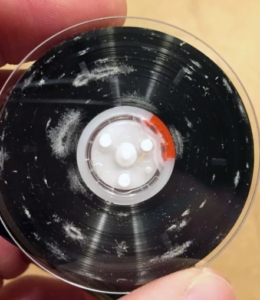WHAT IS STICKY SHED SYNDROME, ANYHOW? Sticky Shed Syndrome (SSS) took the magnetic recording industry by surprise when first encountered in the early 1980s. It was never an issue until tapes were being brought out of storage and refused to play reliably without breaking. SSS in many cases ... Read More »
Care and Handling of Optical Media (CDs, DVDs, and Blu-ray disks)
Adhesive Labels on DVDs and CDs
Adhesive labels should not be applied to optical discs destined for long-term storage (more than five years). The label could delaminate over time and interfere with disc drive operation. The adhesive in some earlier labels has also been known to react with the lacquer surface. Any attempts to peel ... Read More »
A List of DON’Ts for Optical Media
Here is a list of “Do Not Do” practices for you to observe that will maximize the longevity of optical media you are handling. Touch the surface of the disc. Bend the disc. Use adhesive labels. Store discs horizontally for a long time (years). Open a recordable optical disc package if you ... Read More »
Optical Media Dos
Here is a list of dos for you to follow to maximize the longevity of any optical media you may be using. Handle discs by the outer edge or the center hole. Use a non-solvent-based felt-tip permanent marker to mark the label side of the disc. Over time, some marking inks may penetrate the ... Read More »
Scratches on DVDs and CDs
Scratches on the Laser-Reading Side of CDs and DVDs Scratches generally cross data lines or tracks on the disc, and how bad (deep and wide) they are will determine the extent of interference with laser focus on the data. Small or occasional scratches will likely have little or no effect on the ... Read More »
Marking on Optical Media
Marking and labeling a CD or DVD is an essential process in its cre-ation. CDs and DVDs, or their containers, are labeled in some form or fashion so that they can be identified and organized. When label-ing a CD with markers, the composition of the ink in the marker and the style or design of the ... Read More »

